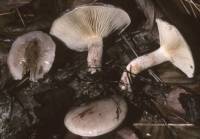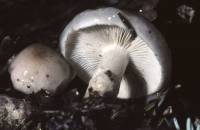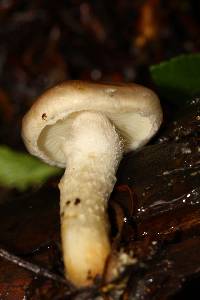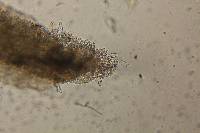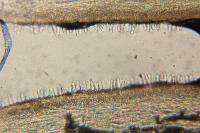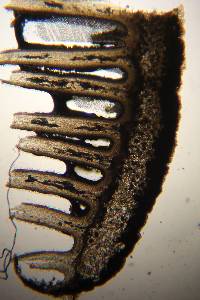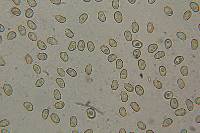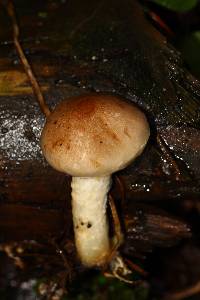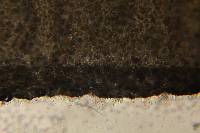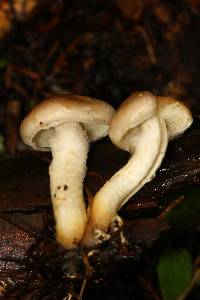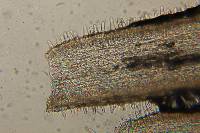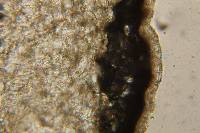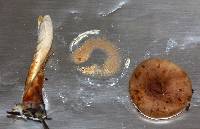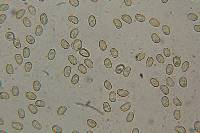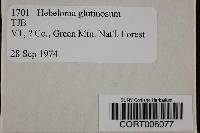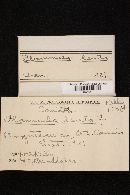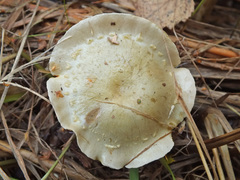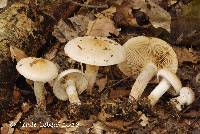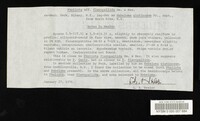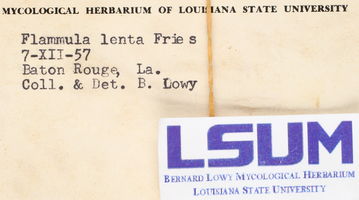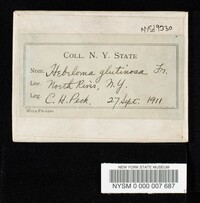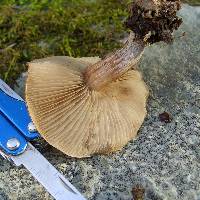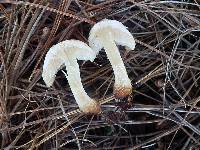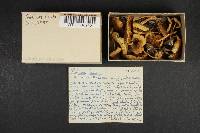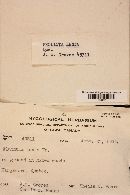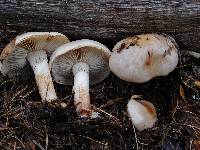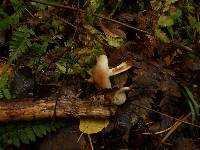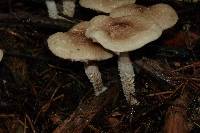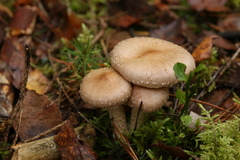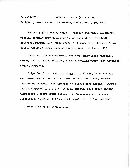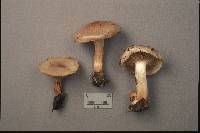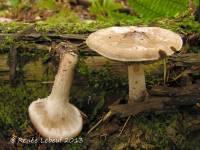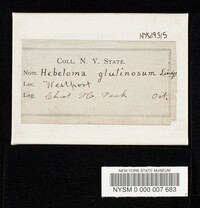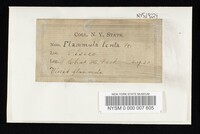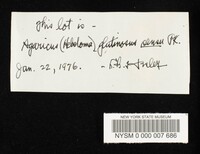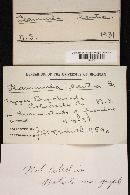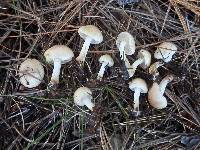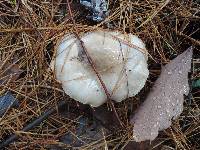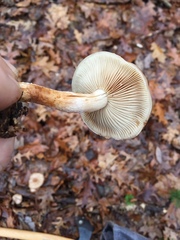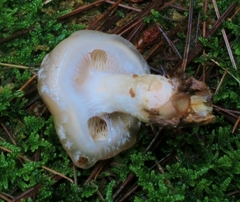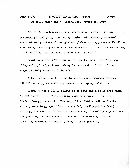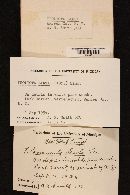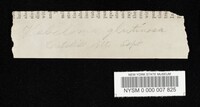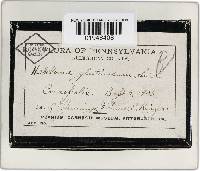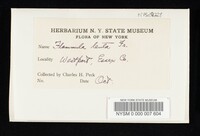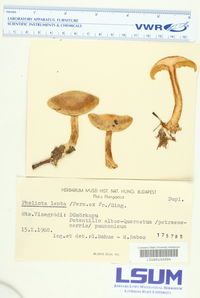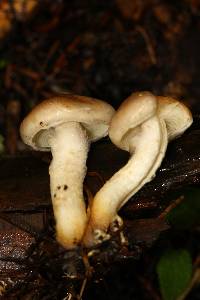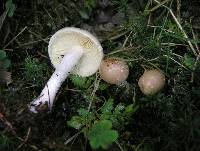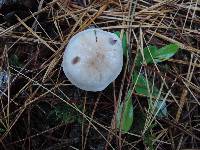
|
|
|
|
Family: Strophariaceae
[Agaricus lentus Pers., moreAgaricus lentus var. lentus Pers., Dryophila lenta (Pers.) Quél., Flammula lenta (Pers.) P. Kumm., Gymnopilus lentus (Pers.) Murrill, Hebeloma glutinosum Sacc., Hebeloma punctatum (Schaeff.) P. Kumm., Pholiotina lenta (Pers.) Singer] |
Smith, AH & LR Hesler (1968) The North American Species of Pholiota. Hafner Publishing Company: New York, NY. 204. Pholiota lenta (Fr.) Singer. Agaricus lentus Fries, Syst. Myc. 1: 253. 1821. Flammula lenta (Fr.) Kummer, Der Führer in die Pilzkunde, p. 82. 1871. Flammula betulina Peck, Bull. Torrey Bot. Club 34: 100. 1907. Gymnopilus lentus (Fr.) Murrill, North Amer. Fl. 10: 204. 1917. Dryophila lenta (Fr.) Quélet, Enchir, Fung. p. 70. 1886. Illustrations: Text figs. 466; 467-470; pls. 11b, 25a, 90. Pileus 3-7 (10) cm broad, convex-hemispheric to convex, finally expanded, whitish to pallid, at times "pinkish-buff," or smoky gray, the disc becoming slightly darker ("avellaneous or even yellowish"), viscid to glutinous, with scattered, white fibrillose-squamulose scales from the broken veil, and often for a long time appendiculate from veil remnants, glabrescent. Context white, firm; odor and taste mild. Lamellae adnate, or with a decurrent tooth, white, then gray-tawny or grayish brown or "clay-color," close, rather narrow to medium broad, abruptly narrowed in front, edges even to fimbriate. Stipe 3-8 (12) cm long, 4-12 mm thick, white above, brownish at the base, fibrillose, apex white-mealy, equal or sub-bulbous, solid or spongy. Veil white, copious, cortinate, leaving an evanescent annulus. Spores 5.5-7 x 3.5-4.5 µ, smooth, apical pore minute, in face view elliptic to oblong, in profile slightly bean-shaped to subelliptic, in KOH more or less ochraceous tawny, in Melzer's reagent ochraceous, wall relatively thin (± 0.2 µ). Basidia 18-23 x 5-6 µ, yellowish in Melzer's reagent, in KOH hyaline or nearly so, almost narrowly elliptic or some slightly ventricose before sporulating, varying to obscurely clavate. Pleurocystidia 42-60 (65) x 8-14 µ fusoid-ventricose, apex obtuse, wall thin and hyaline, content homogeneous, hyaline in KOH (in well dried material). Cheilocystidia 26-30 x 7-10µ, broadly subfusoid, and 28-42 x 9-13 µ, thin-walled, hyaline in KOH, smooth. Caulocystidia scattered or in tufts on a gelatinous "subhymenium," 25-100 x (4) 5-18 µ, fusoid-ventricose with subacute apex, utriform or clavate or clavate-mucronate, thin-walled or wall slightly thickened (less than 0.5 µ), content homogeneous and hyaline ("empty"). Gill trama a central area of floccose thin-walled smooth hyaline hyphae parallel to subparallel and with the cells greatly inflated in age; subhymenium of narrow gelatinous branched hyphae hyaline in KOH. Pileus cutis a thick gelatinous layer of narrow hyaline to yellowish hyphae 1-3 µ diam., appearing to have numerous refractive cross walls at times, smooth, loosely dispersed in gelatinous matrix; hypodermial region of ochraceous to brownish ochraceous floccose hyphae 6-12 µ diam. and with smooth to slightly encrusted walls. Context hyphae inflated, thin-walled, smooth, walls yellowish to hyaline in KOH. All hyphae inamyloid. Clamp connections present. Habit, Habitat, and Distribution: On humus, debris, or humus charged soil, Massachusetts, North Carolina, Tennessee, Michigan, and California, July-December; reported from New York to South Carolina in the eastern United States by Murrill (1917). Observations: The pallid color, small spores, medium sized pleurocystidia, small cheilocystidia and typically white gills when young feature this species. Sterile or semisterile basidiocarps may develop yellow gills, and have caused confusion between this species and P. gummosa. Interesting "abnormal" basidiocarps are rarely found, one of which is described as follows: Pholiota lenta—abnormal variant? Pileus 5 cm broad, plane with a decurved inrolled margin, glutinous when wet, soon merely viscid, disc near "hair brown," toward margin "wood-brown" to "avellaneous" (dark gray to pale grayish brown), staining rusty slightly when bruised. Context pallid, slowly olive in FeSO4; odor none, taste mild. Hymenophore poroid near stipe and lamellate near pileus margin, adnate to pileus and short decurrent on stipe, creamy buff when young and staining tan when injured. Stipe 3 cm long, 14 mm thick, eccentric, equal, solid, surface pallid (concolorous with incurved margin of pileus), with a thin distribution of grayish veil fibrils but lacking a distinct apical zone, staining rusty brown at base when handled. Spores 6-8.5 x 3.5-4 µ, elliptic to subovate in face view, bean-shaped in profile view, smooth, germ pore present but obscure. Basidia 4-spored. Pleurocystidia 48-64 x 9-11 µ, fusoid ventricose, thin-walled, neck broad and apex obtuse to rounded, hyaline to yellowish in KOH. Cheilocystidia similar to pleurocystidia but necks often shorter. Hymenophoral trama of yellowish hyphae (in KOH), the walls smooth; subhymenium gelatinous. Pileus cutis a tangled layer of gelatinous hyaline narrow (2-4 µ) hyphae or possibly the layer trichodermial in origin, in Melzer's yellowish and hyphae showing frequently a peculiar transverse banding; hypodermium of hyphae 8-15 µ diam., walls yellowish in KOH, smooth and non-gelatinous. Context hyphae interwoven, non-gelatinous and merely yellowish in Melzer's. Clamp connections present. Habit, Habitat, and Distribution: On soil in mixed woods, Huron Mts., Big Bay, Mich. June 15, 1963. Smith 66381. Observations: The gills are parasitized by one of the Fungi Imperfecti with narrow hyaline hyphae. This may account for the configuration of the hymenophore. In the fresh condition there was no macroscopic evidence of parasitism. This variant—or whatever one chooses to call it—reminds one of the type of hymenophore described for Psiloboletinus by Singer but of course there is no phylogenetic connection between the two. It does raise the question again, however, as to whether there is any real taxonomic significance in the type of hymenophoral configuration that is part lamellate and part poroid. We know for instance that Amanita muscaria occasionally produces basidiocarps with a poroid to daedalioid hymenium, and now we have this brown spored variant clearly in Pholiota as far as its microscopic features are concerned. Only the basidiocarp illustrated was found in the collection cited, but we have encountered this variation on more than one occasion and old specimens were clearly attacked by a parasite. Material Examined: (typical specimens) CALIFORNIA: Smith 3787; MASSACHUSETTS: Peck (type of Flammula betulina, on dead birch, from Stow, leg. S. Davis, Oct. 4, 1906); MICHIGAN: Harding 440; Hoseney 10-20-65; Kauffman 9-16-29; Smith 5041, 14965, 20894, 33955, 34097, 35997, 38147, 38250, 43426, 44049, 58203, 67338, 67699; NEW YORK: Smith 300; NORTH CAROLINA: (GSMNP): Hesler 10903, 17231. CANADA, ONTARIO: Smith 4433. FRANCE: Josserand 1937. SWEDEN: Fungi Sueici 2692; Hagland 424, 726. SWITZERLAND: Favre 1948. |
|
|
|



